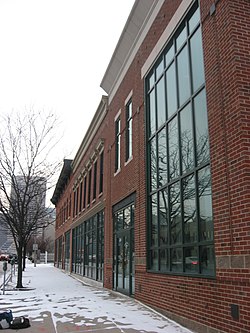Indiana Avenue
|
Indiana Avenue Historic District
|
|

New buildings in the Indiana Avenue Historic District
|
|
| Location | 500 block of Indiana Ave. between North St., Central Canal, Michigan, and West Sts., Indianapolis, Indiana |
|---|---|
| Coordinates | 39°46′29″N 86°9′57″W / 39.77472°N 86.16583°WCoordinates: 39°46′29″N 86°9′57″W / 39.77472°N 86.16583°W |
| Area | 3 acres (1.2 ha) |
| Built | 1869 |
| Architectural style | Italianate |
| NRHP Reference # | 87000912 |
| Added to NRHP | June 12, 1987 |
Indiana Avenue is a historic area in downtown and is one of six designated cultural districts in Indianapolis, Indiana. Indiana Avenue was, during its glory days, an African American cultural center of the area.
In 1870, 974 African Americans (one third of the city's African American population) called Indiana Avenue home. This represented a shift in racial demographics away from the mostly working class poor population of Irish and German immigrants that lived around Indiana Avenue during the early years of Indianapolis. As the African American population increased, black entrepreneurs opened businesses on practically every corner. Bethel AME (African Methodist Episcopal) Church, the oldest African American congregation in Indianapolis, was organized in 1836. African American owned businesses opened on the Avenue by at least by 1865, including a grocery store owned by Samuel G. Smothers and a "peddler shop" owned by William Franklin. The Indianapolis Leader, the first black owned newspaper in Indianapolis, catered to the interests of the growing African American population and featured advertisements for Indiana Avenue businesses.The Indianapolis Leader began publishing in the 1870s.
The avenue continued to culturally develop, in much the same way as the Harlem Renaissance. In fact, due to the nature of segregation and Jim Crow laws, several streets developed similarly including Beale Street in Memphis and 12th and Vine in Kansas City according to the book, Indiana Avenue: Black Entertainment Boulevard by C. Nickerson Bolden. Like Indiana Avenue, these streets were called Black Entertainment Bouelvards, or stops along the Chitlin' circuit because of the large concentration of black-oriented clubs, businesses and entertainment venues.
Many prominent historical figures have their roots on Indiana Avenue: Madam C.J. Walker, jazz greats including Freddie Hubbard, Jimmy Coe, Noble Sissle, Erroll "Groundhog" Grandy and Wes Montgomery.Mary Ellen Cable was one of the most important African American educators in Indianapolis. Coupled with her great work as an educator, she organized and served as the first president of Indiana's NAACP chapter.
...
Wikipedia



